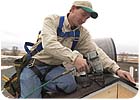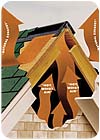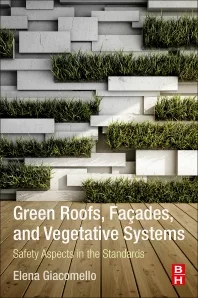Ventilating Metal Roofs Protecting Your Investment

Metal roofs have topped barns, buildings and country homes in the United States since the 1700s. But today's metal roof is nothing like the familiar standing-seam tin roof of years ago. Thanks to modern technology, metal roofs are available in all colors and shades, and many styles are virtually indistinguishable from traditional asphalt shingles, cedar or slate.
The market for metal roofing is expected to grow by nearly 25 percent in the next five years, according to the Metal Roofing Alliance, which maintains that metal roofs are appealing to homeowners and builders alike due to their longer lifespan, durability and energy efficiency. In fact, metal roofs can last 50 years or longer, making them a popular alternative to more traditional roof coverings. Metal roofs, however, can be significantly more costly than asphalt shingles or other more traditional roofing materials. With an investment that can be nearly two to three times the cost of traditional roofing materials, it is important to install an effective ventilation system to properly protect and optimize a new metal roof.

A Simple Concept
Most metal roofs, like other roofing materials, rely on static ventilation, using natural airflow rather than electric fans to create air movement. Static ventilation is a simple concept. It uses the natural effects of rising hot air from outside of the home to remove the heat that builds up in attics in warm weather, and the heat and moisture that collect during cold weather. In a properly vented attic, hot, potentially damaging air is continually replaced by fresh, cool air taken in at the eaves or soffits and exhausted at the upper portion of the roof.Creating a balance between the exhausted air and intake at the eaves is the most important issue to consider when installing a static ventilation system. For every inch of air that is exhausted, the same or greater amount of air should be taken in at the eave. When this occurs, the air will naturally flow from the bottom of the attic to the top, pushing heat and moisture out using air pressure, thermal effect and diffusion.
The United States Department for Housing and Development (HUD) requirements for proper ventilation call for a ratio of 1:300, or 1 square foot of ventilation for every 300 square feet of attic. To ensure a balanced system, 50 percent of the ventilation should be at the eave and 50 percent at the upper portion of the roof. When a ventilation system is unbalanced, the Net Free Area (NFA) is greater at the ridge than at the eave. This can cause a negative airflow that actually can bring air in through the upper portion of the roof. Heat and moisture are then not allowed to escape, and additional moisture can be drawn into the house.
Ensure Energy Savings
Metal roofs, especially those that are lighter in color, can provide significant savings to homeowners when it comes to home cooling costs due to their ability to reflect sunlight. However, proper ventilation is needed to ensure the energy efficiency a metal roof provides. An effectively ventilated roof can help prevent energy waste and excess cooling costs that can happen from attic heat buildup. In addition, proper ventilation can help prevent heat and moisture damage to a building's insulation, which can affect performance.Ridge Ventilation
Ridge vents are an effective way to achieve proper attic ventilation and are becoming a popular option for metal roofs. Ridge vents are installed at the ridgeline of the roof. They run continuously along the entire length of the roof so hot, moist air is continuously released from the attic space across the entire ridge. Ridge vents are easy to install; an opening is first cut along the peak of the roof and the ridge vent is placed over the opening. Cap shingles or cap components are placed on top of the vent, so it virtually disappears into the roofline.
Design Integrity And Durability
The low profile that gives the perception of hidden vents is a key reason ridge vents have grown in popularity in recent years. With ridge vents, homeowners and builders investing in a metal roof do not need to sacrifice when it comes to design and appearance. Ridge ventilation allows for a straight, even roofline and eliminates the need for turbines or box vents. They are easier to install and reduce penetrations in the roof that can lead to moisture infiltration issues.In addition to appearance, it is important that any ventilation system match a metal roof's high durability and toughness. Contractors should look for products that are guaranteed for the life of the roof. Trimline® Ridge Vents are made from a corrugated plastic material that is guaranteed not to crack, dent or damage from hail or ice for the entire life of the roof.
Proper ventilation is a key component of any high-quality roof, and highly durable metal roofs are no exception. Metal roofs are becoming more popular for both residential and commercial projects alike. With the additional installation costs of a metal roof, homeowners will want to ensure their investment is protected. A balanced ventilation system can help maintain the long life of a metal roof and optimize energy savings. Ridge vents are a popular option for metal roofs as they are highly durable, easy to install, yet attractive, creating a smooth, even ridgeline.
Looking for a reprint of this article?
From high-res PDFs to custom plaques, order your copy today!






